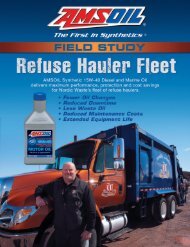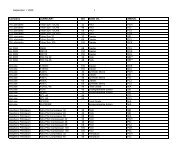AMSOIL P.i. - A Study in Performance (G2543) - Synthetic Motor Oil
AMSOIL P.i. - A Study in Performance (G2543) - Synthetic Motor Oil
AMSOIL P.i. - A Study in Performance (G2543) - Synthetic Motor Oil
Create successful ePaper yourself
Turn your PDF publications into a flip-book with our unique Google optimized e-Paper software.
Heat must escape from the eng<strong>in</strong>e dur<strong>in</strong>g combustion and postcombustion,<br />
and a great deal of it enters the <strong>in</strong>take valve. Once there,<br />
it has three ways of gett<strong>in</strong>g out of the eng<strong>in</strong>e. It can go up the stem, <strong>in</strong>to<br />
the guide and out to the coolant passages; it can go through the valve<br />
seat itself, <strong>in</strong>to the head and <strong>in</strong>to the coolant passages or it can escape<br />
the <strong>in</strong>take valve through the surface on the back side. Any fuel on the<br />
back side of that surface evaporates and contributes to the combustion<br />
process. Because deposits act as an <strong>in</strong>sulator, they block a lot of this<br />
heat transfer and force the heat to go out through the valve seat or valve<br />
stem rather than com<strong>in</strong>g back to the <strong>in</strong>take track to help evaporate the<br />
gasol<strong>in</strong>e.<br />
BMW Valve Deposit <strong>Study</strong><br />
BMW developed a specific <strong>in</strong>terest <strong>in</strong> valve deposits <strong>in</strong> the late 1980s due to drivability problems with its vehicles,<br />
<strong>in</strong>clud<strong>in</strong>g stumbl<strong>in</strong>g, stall<strong>in</strong>g, rough idle and hesitation. A study on valve deposits showed dirty valves were the source<br />
of the problems (Graph B <strong>in</strong>dicates that as valve deposits <strong>in</strong>creased, drivability problems <strong>in</strong>creased), and the company<br />
<strong>in</strong>vested a great deal of time and effort search<strong>in</strong>g for solutions, try<strong>in</strong>g everyth<strong>in</strong>g from polish<strong>in</strong>g the valve surfaces to<br />
us<strong>in</strong>g ceramic-coated valves. The solution that worked<br />
Graph B<br />
was add<strong>in</strong>g a clean<strong>in</strong>g additive to the gasol<strong>in</strong>e.<br />
300<br />
250<br />
200<br />
150<br />
100<br />
50<br />
Graph C<br />
Intake Valve Deposits (mg/valve)<br />
600<br />
400<br />
200<br />
0<br />
0<br />
0 200 400 600 800 1000 1200<br />
Test Method: <strong>Motor</strong>ed Dyno D5500 Type Road Simulation Cycle<br />
79%<br />
Cleanup<br />
58<br />
12<br />
1997 Honda<br />
2.2L Accord<br />
53%<br />
Cleanup<br />
414<br />
193<br />
1997 Jeep 4.0L<br />
Grand Cherokee<br />
36%<br />
Cleanup<br />
212<br />
135<br />
1998 Ford 4.0L<br />
Explorer<br />
98%<br />
Cleanup<br />
49<br />
1<br />
1999 Toyota<br />
1.8L Corolla<br />
91%<br />
Cleanup<br />
61<br />
5<br />
1999 Toyota<br />
2.2L Camry<br />
76%<br />
Cleanup<br />
249<br />
59<br />
1999 Oldsmobile<br />
3.1L Cutlass<br />
70%<br />
Cleanup<br />
Pre Cleanup<br />
Post Cleanup<br />
115<br />
34<br />
2002 Cadillac<br />
4.6L Deville<br />
<strong>AMSOIL</strong> P.i. averaged 72% <strong>in</strong>take valve deposit cleanup across a<br />
wide range of eng<strong>in</strong>e types and sizes, with two cars clean<strong>in</strong>g up<br />
greater than 90%.<br />
Intake Valve Deposit Clean-Up Test<br />
A small fleet test performed on P.i. effectively demonstrates<br />
its superior deposit-clean<strong>in</strong>g abilities. The test focused<br />
on randomly selected model year 1997 to 2002 used<br />
vehicles with between 44,000 and 94,000 miles on<br />
the odometers, and all vehicles had been operated<br />
under normal service conditions us<strong>in</strong>g regular gasol<strong>in</strong>e<br />
available on the market.<br />
Vehicle Model<br />
Mileage<br />
1997 Honda 2.2L Accord 85,000<br />
1997 Jeep 4.0L Grand Cherokee 94,000<br />
1998 Ford 4.0L Explorer 57,000<br />
1999 Toyota 1.8L Corolla 44,000<br />
1999 Toyota 2.2L Camry 53,000<br />
1999 GM 3.1L Oldsmobile Cutlass 52,000<br />
2002 GM 4.6L Cadillac DeVille 55,000<br />
Before P.i.treatment, each vehicle was disassembled,<br />
and <strong>in</strong>take valve deposit levels were measured <strong>in</strong> a<br />
laboratory sett<strong>in</strong>g. Upon completion, the vehicles were<br />
put back together and filled with one tank of P.i.-treated<br />
gasol<strong>in</strong>e. After runn<strong>in</strong>g through that tank of fuel, the<br />
vehicles were brought back <strong>in</strong>to the laboratory, where all<br />
the measurements were taken aga<strong>in</strong>.<br />
The red bars on Graph C represent the pre-treatment<br />
<strong>in</strong>take valve deposit levels of the vehicles, rang<strong>in</strong>g from<br />
49 mg to 414 mg. The blue bars represent the deposit<br />
levels after P.i. treatment, show<strong>in</strong>g an average 72<br />
percent clean-up after only one tank of gasol<strong>in</strong>e. Even<br />
the vehicles with m<strong>in</strong>imal pre-treatment deposit levels cleaned up very well, show<strong>in</strong>g an average 89 percent clean-up,<br />
with the Toyota Corolla show<strong>in</strong>g 98 percent deposit clean-up.<br />
<strong>AMSOIL</strong> P.i.: A <strong>Study</strong> <strong>in</strong> <strong>Performance</strong> 5




